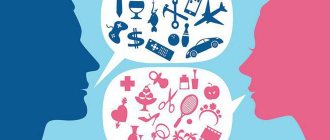Negative attitudes are the most wonderful discovery of psychology. Do you have any doubts?
I don’t, because each of you will agree that if you know the enemy by sight, you can defeat him!
Knowing that you can identify your negative attitudes and remove them is amazing for all of us. After all, this means that you can change your programs in the subconscious and create a new destiny.
Today I want to share with you a great technique that really removes negative beliefs. It just dissolves them... I often give it to my students and together we find and rewrite limiting attitudes.
The results are amazing. Everything we write comes true at the speed of light!!! Don't believe me? Take a look at the results and see for yourself! >>>>
Want to do the practice yourself? Then this article is for you!
What are negative attitudes?
- If we consider this term from a psychological point of view, negative life attitudes are our thoughts and opinions. For example, in one part of the country people think that a salary of 1 thousand euros is normal, but it is quite difficult to live on it.
- In another part of the country, people believe that this salary allows them to live in grand style and not deny themselves anything. Both opinions have a right to exist, because people live in different belief systems.
Types of negative attitudes
- By the age of 12, a person has collected the entire spectrum of beliefs and beliefs. After that, he lives by his own consciousness. He independently creates his life, thoughts and emotions. However, his thoughts will be based on the beliefs he received in childhood.
- Most people find it difficult to change their beliefs as adults. However, if you learn to acquire and strengthen knowledge, there is a great chance of making life the way it appears in our dreams.
Negative thoughts about yourself
Beliefs and health.
Beliefs are our guiding principles. We act as if they are true, regardless of whether they actually are true. NLP takes a pragmatic view of beliefs: they are the principles by which we act, and not necessarily the ones we talk about. Beliefs are generalizations based on past experiences that shape future reactions. They also have no logic. They cannot be proven. They are working hypotheses that we construct for everyday life.
How healthy do you think you are? There are interesting studies by epidemiologists in which subjects were asked to rate their general condition as excellent, good, fair or poor. This self-assessment turned out to be an excellent predictor of how long they lived. Moreover, gender, education, income level and age did not matter. Those people who believed they were in poor health were three times more likely to die over the next seven years. What we believe has a much greater impact on our health than any objective measurement.
Psychology bookap
People with arthritis and high blood pressure may rate their health as good, while those with a mild cold may rate their health as poor. Could this be possible? Yes, because health is a subjective experience, your daily reality, and not something that can be measured and compared with other people.
The degree of health you define for yourself depends on the facts you use as evidence and the comparisons you make. It's important to remain realistic here. If by health we mean five years of all sorts of illnesses, and even the ability to run a marathon, then most likely very few will be able to consider themselves healthy. But if health is defined as balance and the ability to restore and maintain health on one’s own, then it becomes possible to remain a truly healthy person, who may sometimes get sick. Unrealistic comparisons distort our perceptions, which in turn affects our health. As you define health, build a belief about it. Your beliefs about your own health affect how long you live.
Neurobiology about negative human attitudes
- The more often you repeat an action, the stronger the connection of neurons between the brain cells that are activated to perform that action. The greater the activation of neural connections, the more often they work in the future.
- That is, you will perform your usual actions more often. It is believed that no connection is established between unsynchronized neurons.
- The synoptic connection between neurons can always be changed. The more you practice, the more you will strengthen their new position. If you do not repeat your usual actions and negative beliefs, the connection between neurons will become weaker.
Negative health attitudes
Replacing negative attitudes with positive ones: examples
Cause and investigation.
Our beliefs help us explain cause-and-effect relationships. Cause and effect is a suitable explanation when one event follows another without delay and without any deviation. When you cut your hand, it immediately begins to bleed. The further events are separated in time, the more difficult it is to claim that one “caused” the other, because many other events manage to line up in a chain between them.
Psychology bookap
It is very difficult to formulate any simple cause and effect relationship for health. The human body is one of the most complex systems known in this world, and more often than not, there are many causes and connections. Some factors are necessary, but not sufficient for the development of the disease. The virus “causes” the flu, but only when many other factors are present, otherwise everyone in the world would have the flu all the time.
The human body works as a system, always trying to heal itself, even when it seems to be doing the opposite. For example, osteoporosis is a progressive decrease in bone density. The body pulls calcium from the bones, causing them to become even more brittle. Why does the body take calcium? To survive. A certain amount of calcium is necessary for the normal functioning of nerves. Your life depends on how your body uses calcium. When the body cannot get the amount of calcium it needs from food, it is forced to take it from the bones. Food contains enough calcium as long as the body can absorb it, but many foods make this task difficult. Cow's milk contains a huge amount of calcium, as well as phosphorus, which interferes with the absorption of calcium. Animal protein also prevents the penetration of calcium into the human body. The more animal protein you consume, the more calcium your body releases. The traditional Western diet contains triple the protein we need. A diet with enough calcium will not help if the body does not have the ability to absorb it. For osteoporosis there must be a certain diet.
Many symptoms represent the body's attempt to heal itself. Inflammation helps provide the damaged area with more blood and lymph. Increased temperature and fever enable the immune system to do its work faster. When an infection enters the body, it begins to produce chemicals that increase the level of the “thermostat” located in the hypothalamus, which regulates body temperature. When the immune system defeats the infection, these substances stop being produced, and the body breaks out in sweat, trying to cool itself down.
How to identify negative attitudes?
- There is nothing difficult in identifying negative attitudes. It is enough to write down the restrictions in your life on a piece of paper.
- To do this, you will need to have an internal conversation with yourself. Often a person does not even notice that he lives in negative beliefs. This is due to beliefs acquired over many years.
- You must find negative attitudes in your subconscious and write them down. And they should try to hide from you. If you win this game, then you can improve your life.
How to remove negative attitudes forever?
- If you want to get rid of negative attitudes, you need to perform a subconscious deprogramming . Unfortunately, working with the subconscious is quite difficult.
- To clear it, you need to introduce new variables and direct them in the right direction. Analysis of the internal state, awareness of goals and aspirations is the main task of a person.
- If you cleanse your subconscious properly, you can find the cause of the problem. In most cases, they are associated with a person’s psychological thinking. Getting rid of the problem is not difficult. There are several techniques for this, which will be discussed below.
Negative attitudes about relationships
Among the advantages of such techniques are:
- achieving the set goal;
- change in internal state for the better;
- getting rid of negativity;
- opportunity to work with the psyche.
If you get rid of unpleasant moments, you can improve your health. Remember that using deprogrammed techniques is dangerous. If you make a mistake, you can provoke a mental disorder and lead to depression.
Beliefs and meaning.
Beliefs give meaning to experience, they provide stability and understanding, and this is why people sometimes express grim joy if they can say “I knew it would happen this way” when disaster strikes. Beliefs form a system, they fit together to form a structure that gives coherence to our experience.
Psychology bookap
Sometimes changing one belief challenges all others. For example, if emotions can enhance or suppress the immune system, this means that it is actually in my power to decide when to get sick.
Serious illnesses often destroy beliefs. A diagnosis of cancer, for example, changes beliefs extremely quickly. Even a simple illness has a certain meaning. How do you react when you get sick? Is this a blow to you? Does this bother you? Is illness something for you that you need to get rid of as quickly as possible and return to the state you were in before the illness? Do you think you should carry on as usual? Is illness a sign of weakness? Many people do not approve of the behavior of patients; they believe that since they themselves can not give up, then others should behave the same way. Beliefs influence the healing process. Between 20 and 30% of people who have had a heart attack never fully recover because they act like they are incapacitated. Doctors usually recommended that such patients take it easier, but now they have begun to recognize that heart patients should return to their previous activities as fully as possible. Likewise, the effects of a physical injury may limit your activities until you engage in exercise and physical therapy to regain your previous mobility.
Robert Lewin, professor of rehabilitation at the University of Hull, has developed a cardiac rehabilitation program that is run in more than 80 NHS hospitals. The purpose of its creation is to change the thoughts of patients about their illness. He reports that 80% of heart attack survivors attribute their illness to factors that, in their opinion, they are unable to change, such as anxiety, stress, overexertion. These patients do not believe that they are able to manage their lives. Such beliefs further increase fear and depression in a downward vicious spiral, because depression doubles the likelihood of premature death. You will probably only recover as much as you believe you will.
BSFF
- The main goal is to establish a connection with the mind and learn how to change negative attitudes. Once the connection is established, an important process begins. The pace of cleansing your subconscious from negativity will depend on your determination.
- This technique is aimed at identifying the cause of stress . First you need to evaluate your environment (friends, work, family, etc.). Next you need to identify biases. Identify what you are afraid of and what causes anxiety and irritation.
- The next step is to choose a keyword and set the mind. This word should be associated with cleaning (eraser, broom, mop, etc.). Then set the mind: “If a problem appears in life, I will say this word, and you will eliminate it.”
- This technique is only suitable for those who do not show emotions. After successful work, you will be able to withstand stressful situations. Negative attitudes will disappear on their own. Using the BSFF method you can get rid of negative emotions.
Turbo gopher
- This technique is recommended for those who want to change their lives for the better. With its help, it is possible to find peace of mind and peace. The essence of this technique is that a person must realize one thing - he himself is the source of the problem.
- To remove negative attitudes, you should plunge into the subconscious and determine your essence. Either you are a person who cannot take responsibility for your life, or you will be a practitioner who wants to achieve better. Once you choose the second option, you will be able to independently control and banish negative thoughts.
Negative attitudes about money
How to speak
Aspectics
- This method is very effective in releasing negative attitudes. With its help, you can isolate all the negativity into a separate emotion - fear, nervousness or resentment. If you are offended by a person for insulting you, close your eyes and relax. Feel this situation and reproduce the details.
- Say to yourself: “I know that you do not wish me harm. Thank you for this." Determine for yourself what goal you are pursuing. Once you get the answer, write it down. Don't be afraid to reproduce unpleasant situations in your subconscious. This will help you succeed.
PEAT
If you decide to use this system to get rid of negative attitudes, you can use different points on the body:
- chest (in the solar plexus area);
- ocular primary (upper part of the eye);
- ocular secondary (outer corner of the eye).
Place your finger on one of the selected points and say: “Even though there are problems in my life, I love myself and accept myself in this guise.” This ritual must be performed daily. Within a few days you will notice that you have become more balanced and calm.
Negative attitudes are a part of human life. Unfortunately, no one is safe from them. If you want to improve your life and fight negativity, use one of the above methods of subconscious deprogramming.
Useful articles on the site:
- Negative generic scenarios in personal life
- Ho'oponopono Cleansing Method for Beginners
- How to get rid of bad thoughts in your head
- Characteristics and features of karmic relationships
- What are chakras and why should you clean them?
Definition in psychology
The subconscious is a more complex level of the psyche in comparison with consciousness, which regulates mental processes that occur without the participation or with minimal participation of consciousness. For example, with the participation of the subconscious, patterns are formed - a fleeting, not yet formed thought, image, intuitive feeling of danger, inexplicable, unconscious refusal of a potentially risky adventure, control of body movements in extreme situations.
Thanks to the work of the subconscious, a person demonstrates supernatural abilities - super-speed manipulation, super strength, super dexterity. Some blind people, thanks to their developed subconscious, are able to determine the position of objects in space. The subconscious controls the process of breathing and heartbeat - a person does not think about taking a breath or starting the heart mechanism.
The functions of the subconscious include control over the processes of blood circulation and digestion. Examples of the work of the subconscious are sports achievements and meditative practices. A meditating person concentrates his thoughts, experiences emotions and feelings, which accelerate, take on a physical form, a material equivalent.
Researchers believe that an individual is capable of creating and regulating the surrounding reality through mental activity. Another example from the world of sports. A baseball flies at a speed of about 160 km/h. It takes a split second for the ball to reach the batter. During this time, the player’s consciousness is not able to evaluate the flight trajectory and predict the moment of optimal approach when it is necessary to hit the ball.
The process of hitting an approaching target is controlled by the subconscious and only after the action is completed does the player comprehend the situation - assess the accuracy and strength of his strike. The essence of training in many sports is honing a certain action to the point of automatism, when it is subsequently performed on a subconscious level without conscious comprehension and planning.
The subconscious includes genetic experience, which has been accumulated by humanity over the centuries, is constantly supplemented and passed on to representatives of subsequent generations. To develop abilities in any area, you need to rely more on unconscious mental processes such as intuition and reflexive reactions.











